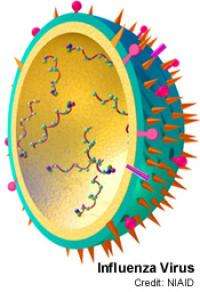Better by design: Engineering flu vaccines

A new computerized method of testing could help world health officials better identify flu vaccines that are effective against multiple strains of the disease. Rice University scientists who created the method say tests of data from bird flu and seasonal flu outbreaks suggest their method can better gauge the efficacy of proposed vaccines than can tests used today.
Rice's Michael Deem, the lead scientist on the project, will present the group's results March 19 at the American Physical Society's 2009 meeting in Pittsburgh. The results are also slated to appear in the forthcoming book "Influenza: Molecular Virology" from Horizon Scientific Press.
Avian flu, or bird flu, is a particularly deadly type of flu that's transmitted from birds to humans. It hasn't yet evolved into a form that can be transmitted readily between humans, but scientists and world health authorities are trying to prepare for a potential outbreak. Because the virus mutates continually, creating a vaccine in advance is problematic. For example, scientists have already found that a vaccine designed for the 1997 strain of bird flu does not work against a 2003 strain.
"Current vaccines contain only a single version of a given flu subtype," Deem said. "We wanted to gauge the effectiveness of a vaccine that contained multiple versions of a given subtype."
World health authorities currently test the efficacy of proposed flu vaccines using either ferrets, which can contract the same forms of flu as people, or genetic assays. Rice's new computerized method could be a cheaper and faster alternative.
With the new method, flu virus mutations are assigned numerical scores. Deem, Rice's John W. Cox Professor of Bioengineering and professor of physics and astronomy, and colleagues developed the method so they could assign a number that captured the amount of difference or similarity between strains. The method can also be used to test how effective a vaccine will be against divergent strains. To verify this, the team checked their results against flu vaccine data collected by the World Health Organization from 1971 to 2004.
"For seasonal influenza, we validated our model against observational data compiled by the World Health Organization's Global Influenza Surveillance Network," Deem said. "We also ran tests against bird flu data. We found that multiple-component bird flu vaccines appeared to be helpful in controlling the simultaneous multiple introduction of bird flu strains."
Influenza viruses are like chameleons. They constantly change the patterns on their outer surface to avoid being targeted by antibodies. This rapid mutation rate is the reason seasonal flu vaccines must be changed annually. However, the vaccines sometimes offer less than ideal protection against newly evolved strains. It takes about six months to produce annual vaccine supplies; also, ideal vaccine strains are often difficult to produce by the standard hen's egg technology, and alternative strains are substituted.
"Oftentimes, bird flu seems to emerge with multiple strains, and something similar can happen with newly released or evolved strains of seasonal flu as well," Deem said. The computational approach Deem will discuss is able to estimate the need for and the efficacy of a multiple-component vaccine in the face of the emergence of multiple flu strains.
Each year, world health authorities create a flu vaccine that protects against three types of seasonal flu -- two subtypes of type A flu and one subtype of type B.
Source: Rice University (news : web)
















